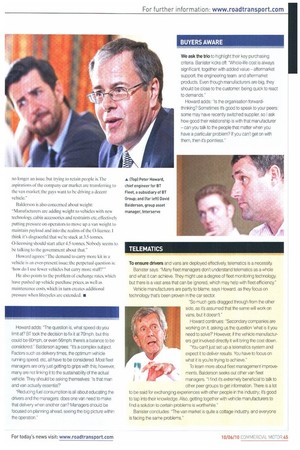CO 2 REDUCTION
Page 44

Page 45

If you've noticed an error in this article please click here to report it so we can fix it.
Another pressure is to reduce carbon emissions, and every major manufacturer now either otters or is developing alternative powertrains. Are these managers convinced of alternative fuels' viability?
Howard answers: "At the moment, you can't go out and source iow-carbon vehicles at a competitive price. ifs going to be a long time before there's going to be anything on the market that stands up in terms of the cost/ emissions balance. particularly the electric route, which has yet to really make an impact."
Banister echoes his thoughts when considering hybrids: 'We've tinkered with a few in the past, none has been really successful in terms of delivering the results we're looking for However, were getting far more tangible results in terms of carbon reduction by focusing on driver
behaviour. Drivers are challenged to make a reduction, while managers have low carbon bonus incentives to make sure that best practice is adhered to."
Howard supports this approach: "You can't achieve change just by putting new vehicles out on the road. If you tap into driver behaviour, you get a much more substantial improvement across the whole fleet in a far shorter time scale."
Banister reveals that some of the fleets for which he is responsible benefit from speed limiters: "We needed to work with the trade unions to convince their members of the benefits of limiters. It was easier for one fleet, as they operated in a bud-up area, so this wouldn't have had such an impact. However, with another that covered a lot of open roads, it took a little more convincing.' Howard adds: The question is, what speed do you limit at? ST took the decision to fix it at 70mph. but this could be 60mph, or even 56mph; there's a balance to be considered.' Balderson agrees: "it's a complex subject. Factors such as delivery times, the optimum vehicle running speed. etc, all have to be considered. Most fleet managers are only just getting to grips with this; however, many are not linking it to the sustainability of the actual vehicle. They should be asking themselves: Is that man and van actually essential?'
"Reducing fuel consumption is all about educating the drivers and the managers: does one van need to make that delivery when another can? Managers should be focused on planning ahead, seeing the big picture within the operation."




























































































































